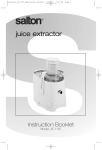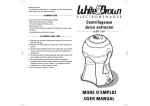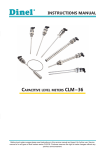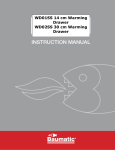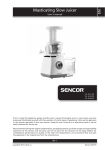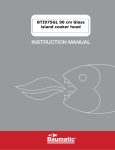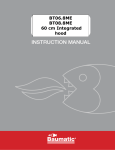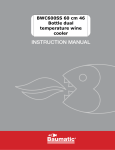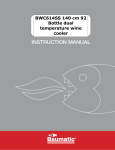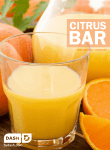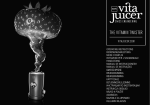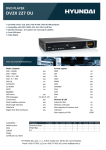Download SJ250ST - Free PDF Hosting
Transcript
SJ250ST Slow Juicer ∆ English User Manual ■ ■ ■ ■ ■ ■ ■ ■ ■ ■ ■ ■ ■ ■ A B 2 ■ ■ ■ ■ ■ SJ250ST ■ ■ ■ ■ ■ ■ ■ ■ ■ ■ ■ ■ ■ ■ ■ ■ ■ ■ ■ ■ ■ ■ F C G D E H 3 ■ ■ ■ ■ ■ ■ ■ ■ ■ ■ ■ ■ ■ ■ L I M J N K 4 O ■ ■ ■ ■ ■ SJ250ST ■ ■ ■ ■ ■ ■ ■ ■ ■ ■ ■ ∆ Introduction Dear customer, Thank you for the confidence you have shown in the Nature7 brand by purchasing this product. The product has been subjected to comprehensive testing of reliability, safety and quality in terms of the prescribed norms and regulations of the European Union. Contact our customer and consulting centre for any questions at: Tel.: +420 222 745 130 Fax: +420 225 277 400 www.nature7.eu Manufacturer: Madal Bal a. s., Průmyslová zóna Příluky 244, CZ76001 Zlín, Czech Republic. Date of issue: 27/04/14 ■ ■ ■ ■ ■ ■ ■ ■ SJ250ST I. Characteristics The Nature7 SJ250ST screw top, low speed juicer is designed for juicing rooted and leafy vegetables, fleshy fruits and berries. Even larger pieces of root vegetables, which are precut before screw top utilization, can be juiced thanks to the removable and retractable slicers. The low speed allows for quality pressing of the flesh, which makes the juice more enriched with vitamins and valuable compounds. The appliance is intended for domestic use and not for commercial service (e.g. in a restaurant). II. Technical Data Order number 569502 Type number SJ250ST Power 250 W Revolutions 85 min-1 Power supply voltage / frequency 220-240 V ~ 50 Hz Juice extraction 80 % Insulation class I Time of continuous operation ≤ 20 min Interval length 20-30 min Weight 5.4 kg III. Components and Control Elements DESCRIPTION OF THE INDIVIDUAL PARTS OF THE Fig. A) JUICER ( M 1) Motor 2) Containers for juice and waste 3) Outlet for juices with flow control 4) Stock tank 5) Sieve embedded within the adjusting sleeve with spatula type device 6) Screw 7) Removable slicer for pre-cutting root vegetables 8) Stock tank cover with filler neck 9) Dish for sliced vegetables and fruit for subsequent infeed 10) Spile for the infeed of fruit/vegetables by means of the filler neck to the screw User‘s Manual ■ ■ ■ ■ ■ ■ ■ IV. Juicer Assembly c ■ ■ ■ ■ ■ ■ ■ ■ ■ ∆ 6 Turning of the silicone sealing position in the outflow status can regulate the flow ( Fig. L). M CAUTION Read carefully the operation manual before assembling and using the juicer. The manufacturer is not responsible for product damage or potential injuries that are caused by improper or careless use of the juicer. Include the instructions for use if you lend out or sell on the juicer and avoid damaging this manual. 8 Thoroughly rinse all parts that shall come into contact with foodstuffs before the initial use of this product! 7 Place containers under the outlet for collecting juices and wastes and insert the spile into the filler neck. The juicer is now ready for use ( Fig. M). M V. Disassembling the Juicer System c NOTE Before disassembling, unplug the power cord from the mains. 1 Make sure that the circular silicone sealing and silicone sealing plug are in good condition before placing the stock tank to the juicer motor. Then insert the silicone plug into the waste outlet opening, otherwise the juice will overflow out of the stock tank ( Fig. B). Proceed in the reverse order of assembly for disassembly steps. M VI. Switch On/Off/Reverse 2 The juicer stock tank rotates as such, that the arrow at the lower edge of the stock tank is set in the unlatched lock position on the device body and after it has been set in place, turn it into the latched lock position. ( Fig. C+D+E). Before plugging the power cord into the mains, check whether the mains voltage corresponds to the range of 220-240 V. The device can be used in this voltage range M The socket must be three-pin (ground), since the juicer is insulation class I. ( Fig. N) M 3 The sieve embedded within the adjusting sleeve with spatula type device rotates as such, that the arrow on the sieve is set in the marking place on the side of the stock tank, afterwards, it is possible to set it on the stock tank itself. Make sure that the adjusting sleeve with spatula type device is correctly fitted in the stock tank. ( Fig. F+G). →→ Press the knob to turn on (screw rotation)”ON/OFF”. →→ To turn off, press the same knob. →→ For rotation movement in the opposite direction in case 4 Insert the screw shaft into the opening in the centre of the stock tank. When juicing root vegetables and celery stalks into the screw centre, attach the supplied slicer for pre-cutting (part 7) ( Fig. H). 8 M M If everything is not aligned correctly, the cover with the filler can not be screwed into the stock tank. 5 The cover with the filler neck rotates as such, that the unlatched lock symbol on the cover is at the place of the triangle on the side of the stock tank. After setting the cover into the stock tank, the cover is to be turned into the latched lock position ( Fig. I+J+K). M c NOTE If the juicer system is not assembled and set properly, the motor cannot be activated due to an interlock switch, that serves as a protection against damage because of poorly deployed components. of blockage hold down the “REV” knob. When you release the button, the movement stops. For the restoration of the original direction of rotation, press the “ON / OFF” knob. After pressing the knob, a red indicator light will light up in the knob. ∆ ■ ■ ■ ■ ■ ■ ■ ■ ■ VII. Preparation of Vegetables and Tips for Juicing 8 Wash the vegetable/fruits, if need be, peel the skin and remove all the unprocessable parts, such as stones from stoned fruit, not doing so will lead to damage to the juicer part of the device. →→ For the juicing of tough root vegetables and celery stalks, proceed with the attached slicer (part 7) prior to the screw, because, in the case of root vegetables, there will be no blockage risk to the screw from larger pieces and in case of celery stalks, there will be no clogging of the waste discharge opening by long threads. ■ ■ c ■ ■ ■ ■ ■ ■ ■ SJ250ST WARNING • Never push material using your fingers or another instrument other than the original spile, since the length of such objects may not affect the screw. • Never add any other materials, such as sugar, apart from fruits and vegetables into the juicer filler neck. This would lead to damage and clogging of the juicer system. →→ If the rotational movement of the screw is blocked during operation, press the “REV” knob and allow the screw to turn in reverse a few times, this should allow for the release of the blocked material. Afterwards, press the “ON/OFF” knob and see whether it is possible to continue juicing. If the screw still doesn’t turn, disassemble the juicer system device, clean and wash it. →→ In the case of leafy vegetables with fine leaves such as lettuce, →→ Do not overload the device. The time of continuous spinach, etc., we recommend finely slicing them and varying them with tough root vegetables to be juiced because the larger parts of leaves tend to stick to the screw, whereby it wont function properly and other portions of leafy vegetables to be added will build up in the juicer storage tank, thus juicing will be restricted and improper waste collection will occur. This occurs even with the juicing of too much ripe fruit such as a lot of soft tomatoes, overripe apples etc. Therefore, it is worth alternating with harder materials. →→ When juicing more mature or softer fruits such as apples, the product shall not be liquid but rather purée. This is a natural occurrence. →→ Soft, non-juicy fruits such as bananas, papaya, figs, as well as hard fruits such as coconut, nuts, etc. are not suitable for juicing. operation should not exceed 20 minutes. The motor is equipped with thermal overload protection, which is no longer functional in the event of overheating. If this happens, wait about 20-30 minutes before its deactivation. The presence of this safety device, however, does not allow for the operation of the device in an overloading manner and does substitute complying with the regular operation mode and intervals! →→ Ensure that the juicer motor is not stood in water. There are ventilation openings beneath the motor, through which water may enter, posing a threat to the motor. →→ Never use the juicer for purposes other than those for which it is designed as well as modify the device in any way for any other purpose. →→ Before starting juicing, we recommend squeezing out the juice from lemons into the container, since it prevents the oxidation of chemicals that are oxygen-sensitive and optionally also browning the juices (e.g. in the case of apple cider). VIII. Operating the Juicer →→ Finely sliced juicing material or soft fruits are to be placed into the dish (part 9) and gradually poured into the filler neck. IX. Cleaning and Maintenance c WARNING Before disassembling the device, always unplug the power cord. 8 Disassemble and clean the juicer system device immediately after use! →→ Without the use of the pre-cutting slicer (part 7), do not →→ When disassembling, follow the assembly steps in reverse →→ In the case of jammed material in the filler neck, feed the →→ Thoroughly clean the sieve from the stuck material using a continuously feed large pieces of hard material, such as root vegetables, into the filler neck but gradually after juicing the previous batch, otherwise this could lead to blockage of the screw and overloading of the motor device. material to the screw by means of the spile (part 10). Do not press the material for juicing using the spile, this will lead to overloading of the motor device. order.→ Rinse the individual parts of the juicer with clean running water at a temperature of 40°C. Never do so with warmer water or in the dishwasher as a higher temperature changes the characteristics of the sealing, which will cease its sealing effect as well as make the plastic brittle and less durable. synthetic brush. Rigorously clean the dry material initially as well as that which is not separated from the pulp during juicing. User‘s Manual ■ ■ ■ ■ ■ ■ ■ ■ ■ ■ ■ ■ ■ ■ ■ ■ ∆ →→ Never use abrasive cleansers when cleaning (e.g., abrasives, XI. Additional Safety steel wool), liquid preparations containing organic solvents (e.g. acetone, ethanol, gasoline, etc.) and bleaching substances such as those based on hypochlorite, hydrogen peroxide, etc. These agents damage the surface of the parts and the motor covering of the device. Brown discolouration of parts is caused by the oxidization natural substances from vegetables and fruit and is not harmful. This is a natural occurrence. 8 When cleaning, we do not recommend using cleaning agents based detergents (saponins), since they are surfactants that may remain on the surfaces in a certain amount after rinsing with warm water, thus, they may be released into the juice. →→ Let the washed parts dry before assembly. Do not expose drying parts to temperatures higher than 40°C. →→ Make sure that the juicer motor does not come into contact with water or other liquids. Air ventilation openings of the motor can be found under the motor unit. →→ If your juicer has stopped working properly, arrange the repair of it with the dealer from whom you purchased the unit or contact the authorized Nature7 service centre (service locations can be found on the website in the introduction of the manual). →→ To ensure correct and safe functioning of the juicer, only original parts from the manufacturer must be used! →→ Avoid contact of all parts of the juicer with direct sunlight, with radiation heat sources and do not put them in the microwave. X. References to Labels and Pictograms M ( Fig. O) Read the manual before use. Conforms to the EU requirements. Device intended for indoor use. Electrical waste. Do not dispose of unserviceable commodities in household waste, but dispose of them in an environmentally safe manner. Serial number Represents the year and month of manufacture and production batch number Guidelines • When juicing, do not look directly into the filler neck, as it can cause eye contact with ejected material. • Norm EN 60335 requires that manuals for products intended for the household contain the following statement: “This appliance can be used by children aged 8 years and older if they are properly supervised or in cases where they have been instructed to use an appliance in a safe manner and understand the potential dangers. The user may not allow children to perform cleaning and maintenance if they are not older than 8 years and under supervision. Keep the appliance and its connection out of the reach of children younger than 8 years. “The appliance may be used by persons with reduced physical, sensory or mental capabilities or with a lack of experience and knowledge, if they are supervised or have been instructed to use the appliance in a safe manner and understand the potential dangers. “Children should not be allowed to play with the appliance.” It is up to the discretion of the parents or overseeing responsible persons, whether they allow their children or the aforementioned persons to use this product. XII. Storage Store the juicer in a dry place, out of the reach of children. Do not expose it to temperatures higher than 40 ° C and direct sunlight. ∆ User‘s Manual EC DECLARATION OF CONFORMITY Madal Bal a.s. • Lazy IV/3356, 760 01 Zlín • Company ID: 49433717 declares that the identified equipment, on the basis of its design and construction, as well the requirements that it was placed on the market to perform, comply with the relevant requirements of the European Union. This declaration loses its validity upon modifications to the product that were not approved by us. Nature7® SJ250ST Screw top, low-speed juicer has been designed and manufactured in conformity with the following norms: EN 60335-1; EN 60335-2-14+A1; EN 550014-1+A1+A2; EN 55014-2+A1+A2; EN 61000-3-2+A1+A2; EN 61000-3-3; EN 62321; EN 62233 and provisions: 2006/95 EC, 2004/108 EC, 2006/42 EC, 2000/14 EC, 2011/65 EU In Zlín: 27/04/14 Martin Šenkýř Member of the Board • DECLARATION OF HEALTH SAFETY Madal Bal a.s. • Lazy IV/3356, 760 01 Zlín • Company ID: 49433717 declares that the below mentioned product meets the requirements of the Decree of the Ministry of Health, No. 38/2001 Coll. as subsequently amended, which specifies the hygienic requirements for products intended for contact with food. This decree, as subsequently amended, implements the European directives issued by the European Union. Nature7® SJ250ST In Zlín: 27/04/14 Martin Šenkýř Member of the Board










